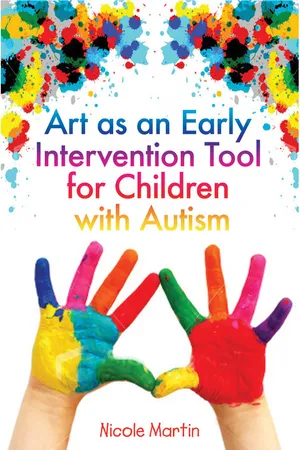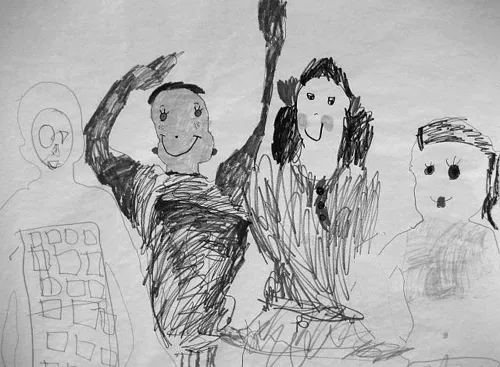![]()
1
Introduction to Autism Spectrum Disorders (ASD)
This chapter is designed to give readers who do not know much about autism a basic introduction to the disorder. A functional knowledge of autism is necessary in order to understand this book. Professionals working in the field or parents might consider skipping this chapter, but I would strongly encourage students, new professionals, and artists to read it carefully and check out the recommended websites listed at the end of the chapter.
What is autism?
Autism is defined by the current Diagnostic and Statistical Manual of Mental Disorders (American Psychiatric Association 2000) as a neurological disorder characterized by qualitative impairment in social interaction and communication as well as the presence of “restricted, repetitive, and stereotyped patterns of behaviors, interests, and activities” (American Psychiatric Association 2000, p.71). At present, we do not know what causes autism, therefore it is primarily described according to its signs and symptoms (how the person behaves). Traditionally, we think of autism in terms of what is referred to as the “triad of impairment”: socialization, communication, and imagination. To greater or lesser degrees, these three problem areas have to manifest themselves in a person in order for them to receive a diagnosis of autism.
Children with autism truly represent a “spectrum” of talents, interests, and abilities.
Socialization problems may present as disengagement, abruptness, lack of expressed empathy, or poor eye contact, among other things. Activities that we think of as making friends, remembering your manners, or maintaining relationships can be incredibly foreign to a child with autism. Socially based emotions like embarrassment or competitiveness often just do not exist. It can be difficult when a child prefers to be alone or does not seem particularly attached to other people, but children with autism do crave human affection and attention just like anyone else. Spend some time with them and you will see what I mean.
Difficulties with communication have to do with both the relative lack of it as well as common grammatical or syntax errors. Contextual questions (e.g., why did something happen) and pronoun use are common problem areas. Using figures of speech (e.g., “go jump in the lake”) might be confusing for some children with autism, as they tend to be very literal, concrete thinkers. Difficulty expressing appropriate emotions can tangle up communication as well. The child’s emotion may not match his or her message (e.g., laughing after sharing that the dog died) or if the child is experiencing strong emotions (such as frustration, sadness, desire, etc.) verbal communication may completely break down. A perceived halt in language development or even a loss of previously learned words is one classic indicator of autism, although, like other features, it does not necessarily apply to everyone. Many people with autism have large vocabularies and are primarily verbal communicators. Those who do not develop verbal language are often taught to communicate using visual languages, like exchanging picture cards or sign language. Overall, receptive language skills (understanding what is said) tend to be stronger than expressive language skills (speaking with clear communicative intent) for people with autism.
Imagination deficits can be a bit tricky to pinpoint, especially since, in my opinion, they are bound up with the child’s need for a sense of order/control and sensory regulation. Symbolic play (or “pretend play”) and creative activities (like art) require some exercise of the imagination, and rarely come naturally to a child with autism. Suppositions (e.g., what would you do?) can be very challenging, and the child will often search for a “correct” answer without understanding that there is no right or wrong when it comes to using your imagination. Difficulties with imagination may be related to a field of study called theory of mind, which is the ability to put yourself in another person’s shoes, or imagine what they might be thinking. (Theory of mind is often considered to be a possible “fourth impairment” of autism.) What the Diagnostic and Statistical Manual of Mental Disorders (DSM) refers to as “restricted, repetitive, and stereotyped patterns of behaviors, interests, and activities” often present as a strict daily routine, getting very upset over minor interruptions in a favorite activity, a need to order the environment (even if it looks messy to us), and/or having a very short list of interests. Much of this inflexibility has to do with the person’s need to regulate their sensory input. People with autism can be hyper (over) or hypo (under) stimulated by their environment, and it is often difficult to anticipate when or how this might happen. The sound of a crying baby or the jostle of a crowd, for example, can generate such strong anxiety in a child with autism that it makes perfect sense that they would try to circumscribe their daily activities as much as possible. Sensory needs can trump imaginative, exploratory (i.e., risky) endeavors. Therapeutic art-making provides a variety of sensory stimulation in a safe, organized environment using activities that can crack open the door to a child’s imagination.
There are three terms that are important to be familiar with when working with people with autism: scripting, perseverating, and stimming. These are very common behaviors displayed by people with autism, mostly related to their sensory and control needs.
Scripting is a tendency to recite words or phrases that usually, but not always, originate from some outside source (e.g., quoting lines from a book or a T.V. show). Scripting is different from parroting, which is when a person repeats your words back to you (e.g., asking, “How are you?” and getting “How are you?” in response). Some people may use a script as a way to express themselves (e.g., saying “Hasta la vista, baby” from the Schwarzenegger movie instead of “I don’t feel like working today”). Teaching the child an appropriate variety of “scripts” to use for different situations is often part of therapy.
Perseverating is an obsession with a topic. It does not have the word-for-word repetition of a script. A child might, for example, perseverate on baseball. It is good to have a passionate interest, but when you talk about baseball so much that it interferes with your ability to focus at school, it is a problem. Sometimes therapists or teachers refer to compulsive or repetitive behaviors (like turning a light switch on and off, or making only one stroke over and over with a paintbrush) as perseverating.
Stimming is shorthand for self-stimulating behaviors, which are odd behaviors that nevertheless satisfy the child’s need for more, or different, sensory stimulation. Hand-flapping, spinning objects, hair-stroking, tongue-clicking, and so on are all “stims.” Sometimes strong emotions, like frustration or excitement, can “overload” the sensory system and result in stimming. In some children stimming might manifest as inappropriate or self-injurious behaviors such as hair-pulling, public masturbation, or head-banging.
Since the characteristics and behaviors described above present to greater or lesser degrees in each individual, you can imagine the great variety of similarities and differences there can be among people with autism. Individuals with autism are often described by teachers and therapists as either “high functioning” (i.e., verbal, in mainstream classroom, etc.) or “low functioning” (i.e., nonverbal, severe sensory issues, etc.).
Disorders that are very similar to autism (technically called “autistic disorder”) and yet retain their own different distinctions “on the spectrum” include childhood disintegrative disorder, pervasive developmental disorder not otherwise specified (PDD-NOS), Asperger’s syndrome, and Rett’s syndrome (see Table 1 for descriptions). To reflect this range, professionals now refer to autism as “autism spectrum disorder” (ASD). This book uses the terms “autism” and “autism spectrum disorder” (ASD) interchangeably since both are currently acceptable. Additional disorders such as seizure disorder, apraxia, fragile X syndrome, celiac disease, nonverbal learning disability, receptive and/or expressive language disorder, obsessive-compulsive disorder, attention deficit hyperactivity disorder, and dyslexia are sometimes considered to be part of an even broader continuum of ASD-like symptomology and therapists who work with children on the spectrum can usually treat these children as well. It is not uncommon for a child to have both a spectrum diagnosis and a diagnosis from this broader continuum.
It is important to note that autism is not the same thing as mental retardation (MR), although the majority of people with autism do have MR to some degree as well. MR is simply a classification for an individual whose IQ (often still measured using the Stanford-Binet or Wechsler) is below 70 points. Standardized testing is difficult to do with children on the spectrum due to their attention and communication deficits, so it is very possible that many children test lower than their actual level of intelligence. It is possible to have a diagnosis on the spectrum and have normal or even above average intelligence (usually more common with a diagnosis of Asperger’s), although it is not terribly common. Individuals with more severe disability may always need help with toileting and hygiene and may or may not be able to benefit from inclusive academic environments.
Table 1 Brief summary of ASD as described in the Diagnostic and Statistical Manual of Mental Disorders IV-TR (American Psychiatric Association 2000) and the International Classification of Diseases-10 (World Health Organization 1992). |
| Autism spectrum disorders (ASD) or autism |
| 1.Autistic disorder (DSM), childhood autism (ICD) |
| Social, communication, and imagination impairment plus restricted and repetitive behaviors (what most people think of when they use the word “autism”). |
| 2.Rett’s syndrome |
| Similar to 1. but present only in females (very unusual; all other disorders are mostly present in males), head growth deceleration, loss of skill using hands, and poor coordination. |
| 3.Childhood disintegrative disorder |
| Similar to 1. but clear regression after two or more years of normal development (children referred to as having “lost their words” or “retreating within themselves”). |
| 4.Asperger’s syndrome |
| Similar to 1. but no delay in language development or cognition (independent living is likely). |
| 5.Pervasive developmental disorder not otherwise specified (PDD-NOS) (including atypical autism) |
| Social and communication impairment and stereotyped behaviors present, but do not technically fit the full criteria for one of the categories above (often referred to as “high functioning” autism). |
Savants (individuals who display an extraordinary and specific genius despite their autism which severely impairs other aspects of their lives) definitely get more media coverage than the average person with autism. While they are inspirational examples of the miracles and mysteries of the human brain, they are atypical (as rare as genius in the general population) and should not be thought of as an example of a typical person with autism.
So what is the most likely explanation for autism? Heredity. Scientists have been able to identify several genes that are close to, or in the neighborhood of, genes that will probably be implicated in autism. Also, it has been shown that identical twins, who share 100 percent of their genes, are much more likely both to have autism than are non-identical twins who only share about half of their genes. One thing is for sure, whether or not a person has autism is determined by a complicated mix of factors. There is compelling testimony that environmental factors such as food allergies, gastrointestinal problems, abnormal reaction to the thimerosal formerly present in the MMR (measles-mumps-rubella) vaccination, mercury build up in the body, trauma at birth, and a vulnerable immune system might play roles. In other words, just the right cocktail of genes in a person’s genetic code combined with a triggering environmental factor or two might explain the origin of a person’s autism. This nature plus nurture view is currently a popular way to explain a large variety of mental health problems, and we will have to wait and see whether or not it pans out as an explanation for autism. In the meantime, paren...

